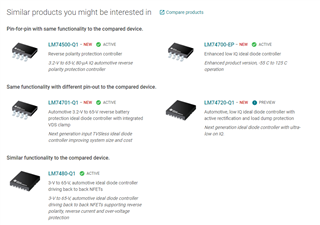Other Parts Discussed in Thread: LM74700-EP
Hi TI Experts,
We used LM74610 as battery reverse protection solution, we measure pulse waveform on output port, it is not what we expect.
We got LM74700 can output constant DC power, we see following chips have similar function: LM74500,LM74700-EP(-55℃ ~125℃ wider operation temperature range), LM74701, LM74720;
The quiescent current/shutdown current/input voltage range are similar, the PCB package and operation temperature are different.
I can not see obvious difference. Please explain key features differences between LM74500/LM74700-EP/LM74701/LM74720;

Thanks,
Joseph

